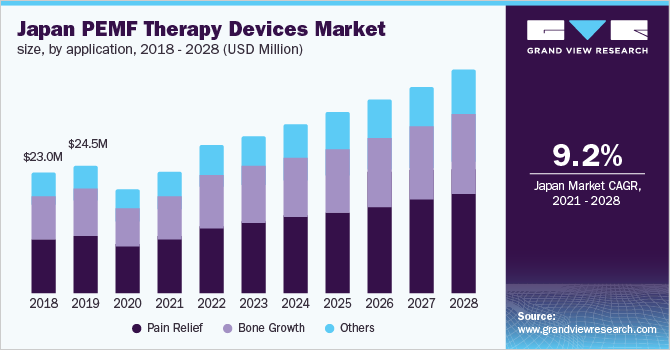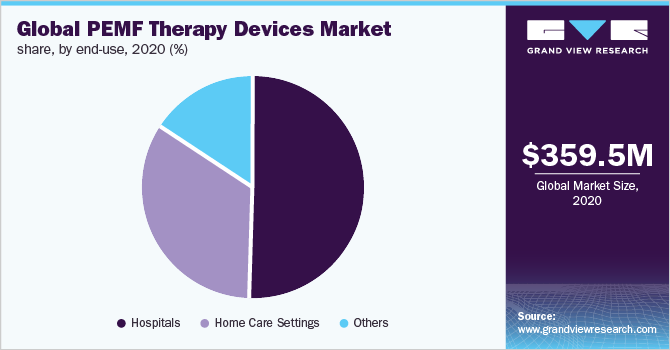- Home
- »
- Medical Devices
- »
-
Pulse Electromagnetic Field Therapy Devices Market Size Report, 2030GVR Report cover
![Pulse Electromagnetic Field Therapy Devices Market Size, Share & Trends Report]()
Pulse Electromagnetic Field Therapy Devices Market Size, Share & Trends Analysis Report By Power (Low Frequency, High Frequency), By Application (Bone Growth, Pain Relief), By End Use, And Segment Forecasts, 2024 - 2030
- Report ID: GVR-4-68039-670-4
- Number of Report Pages: 80
- Format: PDF, Horizon Databook
- Historical Range: 2018 - 2022
- Forecast Period: 2024 - 2030
- Industry: Healthcare
Report Overview
The global pulse electromagnetic field (PEMF) therapy devices market size was valued at USD 523.4 million in 2023 and is projected to grow at a compound annual growth rate (CAGR) of 6.0% from 2024 to 2030. The market was primarily driven by the increasing awareness and acceptance of PEMF therapy for its non-invasive and drug-free approach to pain management and healing. As more clinical studies and patient testimonials highlighted the benefits of PEMF therapy, its adoption significantly grew among both healthcare professionals and patients.

In addition, technological advancements such as the development of narrow, miniaturized, portable, and user-friendly PEMF devices made the therapy more accessible to a broader audience. These advancements include the development of compact, lightweight devices that can be easily used at home, thereby increasing the convenience for patients. Additionally, the integration of telemedicine and advanced materials and improved battery life in these devices enhanced their effectiveness and usability.
The rising prevalence of chronic diseases and conditions such as arthritis, osteoporosis, and fibromyalgia contributed to the market growth. PEMF therapy has been increasingly recognized for its potential to alleviate symptoms associated with these conditions, providing a complementary treatment option that can improve patient’s quality of life. Furthermore, the growing elderly population, who are more susceptible to chronic pain and musculoskeletal disorders, drove the demand for effective pain management solutions including PEMF therapy.
Moreover, PEMF therapy provides a novel alternative for the treatment of various musculoskeletal disorders. PEMF devices have been approved by the U.S. FDA to treat non-union fractures and cleared to treat post-operative osteoarthritis, plantar fasciitis, pain, and edema. These devices have several benefits including the reduction of chronic and acute pain related to several connective tissues, including bone, tendon, ligaments, cartilage injury, edema, and inflammation control.
Power Insights
Low frequency PEMF devices dominated with a 60.2% market share in 2023. These devices have gained significant traction due to their effectiveness in providing therapeutic benefits with minimal side effects. Low frequency devices typically operate at frequencies below 1000 Hz, which are particularly effective for pain management, bone healing, and reducing inflammation. Moreover, as the global population ages, conditions such as arthritis, osteoporosis, and chronic back pain have become more common, leading to a higher demand for effective, non-invasive treatment options including low-frequency PEMF therapy. Additionally, the growing awareness and acceptance of alternative and complementary therapies encouraged more patients and healthcare providers to adopt PEMF devices.
High-frequency PEMF devices are expected to emerge at the fastest CAGR during the forecast period. These devices, which operate at frequencies above 1000 Hz, gained popularity due to their enhanced ability to stimulate cellular repair and regeneration. High frequency devices are particularly effective in treating acute injuries, promoting faster healing, and reducing inflammation.
Application Insights
Pain management applications dominated the market in 2023. The surge was primarily stimulated by the rising prevalence of chronic pain conditions such as arthritis, fibromyalgia, and lower back pain. PEMF therapy devices provide an optimal magnetic field that reduces pain by enhancing the expansion and contraction of cells and by detoxifying and regenerating damaged cells. Additionally, innovations such as improved battery life, enhanced portability, and user-friendly interfaces make these devices more accessible and convenient for home use. This aligns with the growing trend of home healthcare, driven by the increasing adoption of telemedicine and remote patient monitoring.
The bone growth segment is projected to emerge at a CAGR of 5.3% over the forecast period owing to the increasing incidence of bone-related conditions such as osteoporosis, fractures, and delayed union of bones. Pulsed electromagnetic field therapy devices are known to act on bone and osteoblasts, affecting their metabolism with improved signal modulations, enhanced portability, and user-friendly interfaces. The growth of PEMF therapy and its development for usage in post-operative bone growth has been innovative in its effect on vascular flow and bone tissue proliferation. Moreover, numerous clinical trials have discovered that PEMF therapy devices are capable of promoting osteogenesis and considerably increasing bone mineral density.
End Use Insights
Hospitals accounted for the dominant market share of 50.8% in 2023 owing to the rising prevalence of chronic pain and musculoskeletal disorders. Hospitals, as primary healthcare facilities, witnessed a rise in patients with conditions such as arthritis, osteoporosis, and chronic back pain, which require effective pain management and rehabilitation solutions. PEMF therapy offers a non-invasive, drug-free alternative that has considerably gained acceptance among healthcare providers. Increasing hospital admissions of patients suffering from spinal injuries, traumatic injuries, fractures, and road accidents are expected to accelerate the segment's growth.

Home healthcare is expected to emerge as the fastest-growing segment over the forecast period. With the increasing adoption of telemedicine and remote patient monitoring, patients have increasingly sought convenient and effective treatment options that can be used at home. PEMF therapy devices, being non-invasive and easy to use, fit well into this trend, allowing patients to manage their conditions from the comfort of their homes. Additionally, the expanding body of clinical research validating the efficacy of PEMF therapy has boosted market confidence. Positive outcomes from these studies have significantly encouraged more patients and healthcare providers to adopt PEMF devices for home use.
Regional Insights
The North America pulse electromagnetic field therapy devices market dominated with a 41.4% share in 2023 owing to the growing number of individuals with osteoporosis and osteoarthritis. In addition, the ongoing transition towards minimally invasive procedures is predicted to enhance regional growth.
U.S. Pulse Electromagnetic Field Therapy Devices Market Trends
The pulse electromagnetic field therapy devices market in U.S. is expected to be driven by the country’s well-established healthcare infrastructure and technological advancements. Innovations such as improved signal modulation, enhanced portability, and user-friendly interfaces make these devices more accessible and convenient for both clinical and home use with improved efficacy.
Europe Pulse Electromagnetic Field Therapy Devices Market Trends
The Europe pulse electromagnetic field therapy devices market held a significant market share of the global revenue share in 2023 owing to the increasing prevalence of chronic pain and musculoskeletal disorders including arthritis, osteoporosis, and lower back pain. As the population ages, these conditions have become more common, leading to a higher demand for effective, non-invasive treatment options such as PEMF therapy.
Asia Pacific Pulse Electromagnetic Field Therapy Devices Market Trends
The Asia Pacific pulse electromagnetic field therapy devices market is expected to grow at the fastest CAGR over the forecast period owing to the increasing patient awareness about PEMF therapy devices' availability and continual advancements in healthcare infrastructure. The growth of the regional market is also projected to be fueled by the growing demand for home healthcare and the rising number of elderly individuals in various developing countries in the region.
Key Companies and Market Share Insights
The global pulse electromagnetic field therapy devices market is fragmented with key market participants such as Bedfont Scientific Ltd., Orthofix Medical Inc., and others. These companies have heavily focused on regulatory product approvals, mergers & acquisitions, strategic collaborations, and product launches to sustain and enhance their worldwide presence.
-
Bedfont Scientific Ltd. specializes in the manufacturing and designing exhaled gas and breath monitoring instruments for medical, scientific, and industrial markets. Their product range includes Smokerlyzer device to cease smoking and the NObreath device which measures airway inflammation and manages asthma.
-
Orthofix Medical Inc. offers a comprehensive portfolio of spinal hardware, biologics, orthopedic solutions, and bone growth therapies. The company is dedicated to improving patient mobility and quality of life through innovative medical devices and solutions.
Key Pulse Electromagnetic Field Therapy Devices Companies:
The following are the leading companies in the pulse electromagnetic field therapy devices market. These companies collectively hold the largest market share and dictate industry trends.
- Bedfont Scientific Ltd.
- Orthofix Medical Inc.
- I-Tech Medical Division
- Oska Wellness
- Medithera
- NiuDeSai
- Nuage Health
- Oxford Medical Instruments Health Store
- Bemer USA, LLC
Recent Development
- In December 2023, Orthofix Medical Inc. announced the release of the latest data from a multicenter study. This study explores the use of Pulsed Electromagnetic Field (PEMF) stimulation as an additional therapy for patients at risk of pseudarthrosis. The findings highlight the outcomes for patients who are treated with SpinalStim device.
Pulse Electromagnetic Field Therapy Devices Market Report Scope
Report Attribute
Details
Market size value in 2023
USD 552.0 Million
Revenue forecast in 2030
USD 784.0 Million
Growth rate
CAGR of 6.0% from 2024 to 2030
Base year for estimation
2023
Historical data
2018 - 2022
Forecast period
2024 - 2030
Quantitative units
Revenue in USD Billion and CAGR from 2024 to 2030
Report coverage
Revenue forecast, company ranking, competitive landscape, growth factors, and trends
Segments covered
Power, Application, End Use, and Region
Regional scope
North America, Europe, Asia Pacific, Latin America, MEA
Country scope
U.S., Canada, Mexico, UK, Germany, France, Italy, Spain, Denmark, Sweden, Norway, China, Japan, India, Australia, Thailand, South Korea, Brazil, Argentina, Saudi Arabia, South Africa, UAE, Kuwait
Key companies profiled
Bedfont Scientific Ltd.; Orthofix Medical Inc.; I-Tech Medical Division; Oska Wellness; Medithera; NiuDeSai; Nuage Health; Oxford Medical Instruments Health Store; Bemer USA, LLC
Customization scope
Free report customization (equivalent up to 8 analyst’s working days) with purchase. Addition or alteration to country, regional & segment scope
Pricing and purchase options
Avail customized purchase options to meet your exact research needs. Explore purchase options
Segments Covered in Report
This report forecasts revenue growth at global, regional, and country levels and provides an analysis of the latest industry trends in each of the sub-segments from 2018 to 2030. For this study, Grand View Research has segmented the global pulse electromagnetic field (PEMF) therapy devices market report based on power, application, end use, and region.
-
Power Outlook (Revenue in USD Million, 2018 - 2030)
-
Low Frequency
-
High Frequency
-
-
Application Outlook (Revenue in USD Million, 2018 - 2030)
-
Pain Management
-
Bone Growth
-
Others
-
-
End Use Outlook (Revenue in USD Million, 2018 - 2030)
-
Hospitals
-
Home Care Settings
-
Others
-
-
Regional Outlook (Revenue in USD Million, 2018 - 2030)
-
North America
-
U.S.
-
Canada
-
Mexico
-
-
Europe
-
U.K.
-
Germany
-
France
-
Italy
-
Spain
-
Denmark
-
Sweden
-
Norway
-
-
Asia Pacific
-
China
-
Japan
-
India
-
Thailand
-
Australia
-
South Korea
-
-
Latin America
-
Brazil
-
Argentina
-
-
Middle East and Africa
-
Saudi Arabia
-
South Africa
-
UAE
-
Kuwait
-
-
Share this report with your colleague or friend.
![gvr icn]()
NEED A CUSTOM REPORT?
We can customize every report - free of charge - including purchasing stand-alone sections or country-level reports, as well as offer affordable discounts for start-ups & universities. Contact us now
![Certified Icon]()
We are GDPR and CCPA compliant! Your transaction & personal information is safe and secure. For more details, please read our privacy policy.
We are committed towards customer satisfaction, and quality service.
"The quality of research they have done for us has been excellent."





